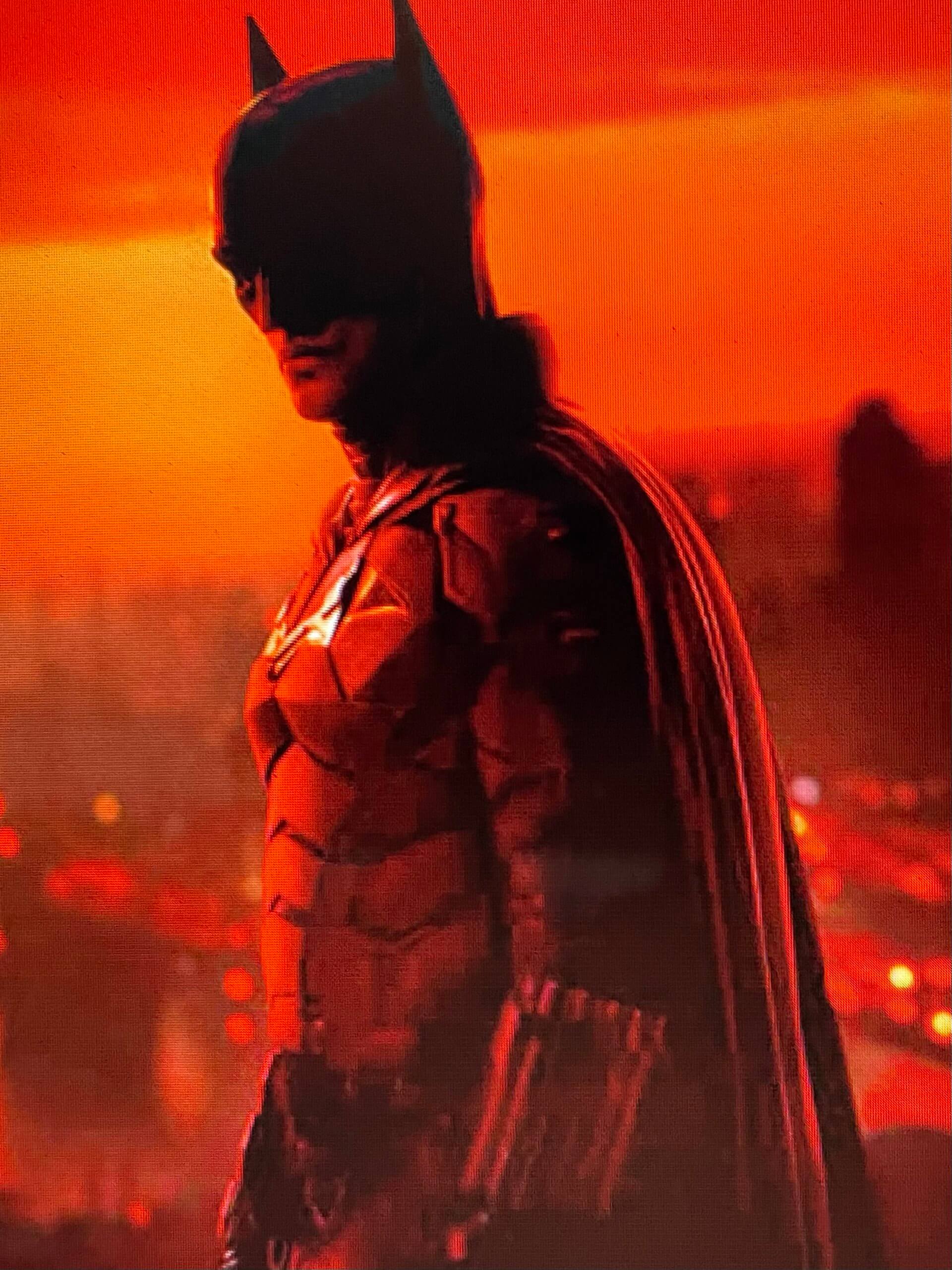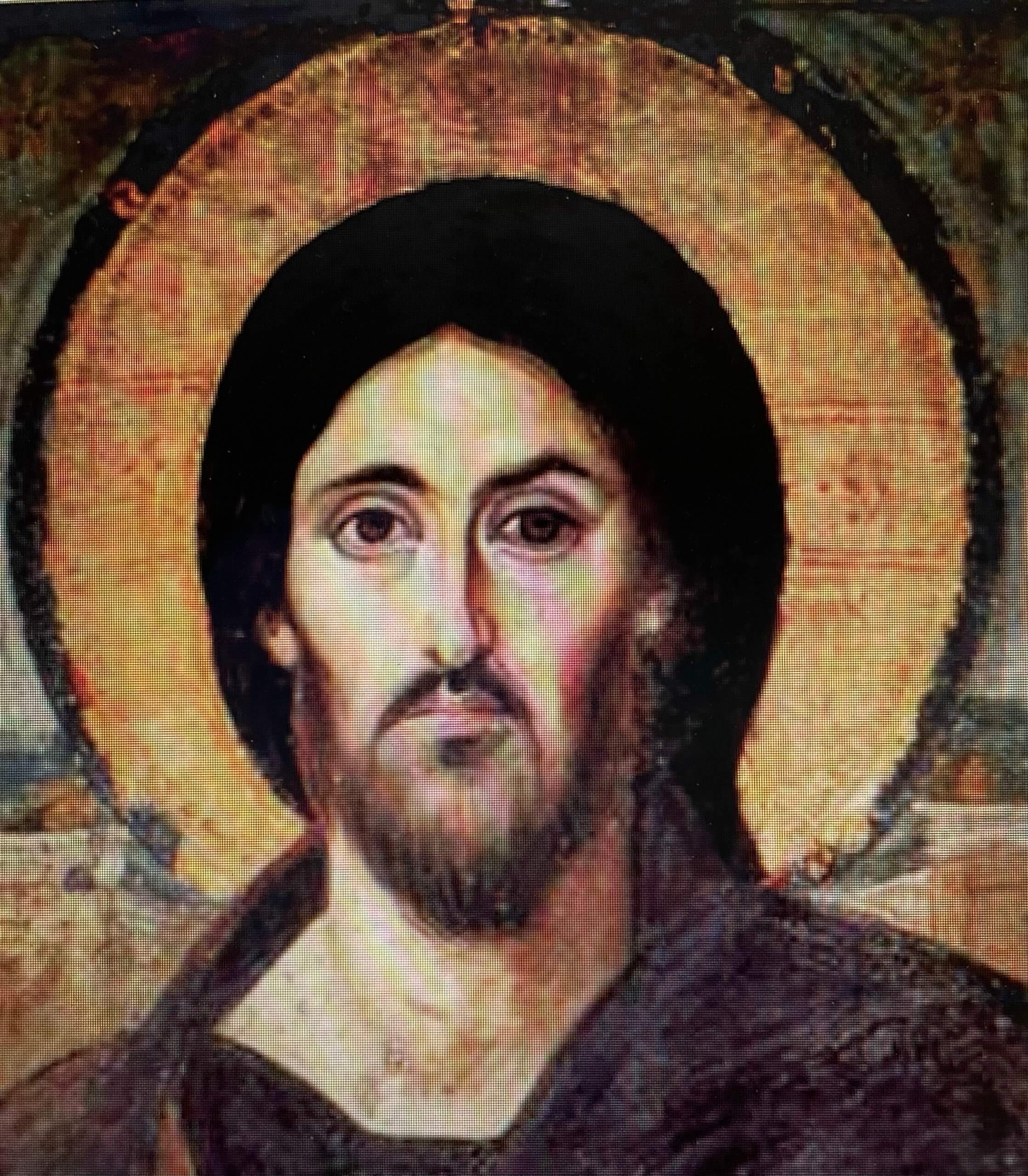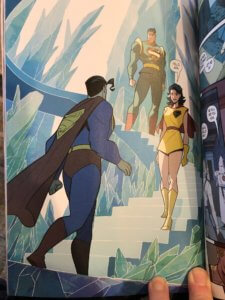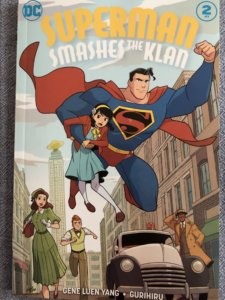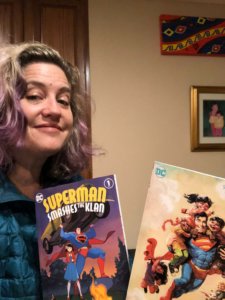Posts Tagged ‘DC Comics’
THE BATMAN, God and Justice. Warning: So Many Spoilers
Last night I had the privilege of watching Matt Reeve’s THE BATMAN. I enjoyed the film, though it was tough to watch, a tense experience. Graphic violence is implied more than shown, but evil and darkness are palpable in every scene. Not that the film isn’t a beautifully crafted story…the dingy special effects are stylized to evoke the brokenness of Gotham. They reveal a failing society in every frame. It’s pouring rain and night during most of THE BATMAN, and of those scenes shot in the day, the skies are gray.
Of course, this is a familiar setting for our comic book hero, the Dark Knight, but what is less familiar is the tone of utter hopelessness associated with that darkness. Violence plagues the city of Bruce Wayne. In the opening sequence, it is Halloween night and masked hoodlums run wild across Gotham causing mayhem, and at one point a gang of them threaten an Asian American man in a subway station, hitting too close to home for many of us. Halloween is also the night the Riddler commits his first murder.
The brutality of humanity is on display in THE BATMAN, begging the question: When is a society so corrupt, so evil, so far gone, there is no hope of renewal and it must be destroyed? This film earned a PG-13 rating. It’s possible a mature teen could watch this and grapple with the question posed above. It’s a hard question, but one that ought to be pondered by all of us.
The rivalry between Batman and the Riddler draws out themes of righteousness versus justice. In certain respects, both men are the same. Both are trying to root out corruption, Both are straining toward a just society. Batman roots out injustice by defending the good guys and working within the system. Though outside the formal police force, his link to Lt. Gordon cannot be denied, nor can anyone doubt his insider status as Bruce Wayne, the orphaned son of a beloved city father. The Riddler however, also an orphan, stands on the outside. He roots out evil by exposing it, by punishing via execution and making a public example of those who have betrayed justice. The Riddler’s first murder is the mayor of the city and subsequently other politicians and law enforcement, those caretakers of Gotham who have made their beds with the mob. Because of these assassinations and the attention he draws to corruption, Batman along with the audience are forced to focus on what is a massively broken system at the highest levels of the city.
The audience wonders whether ANY politicians or police are clean in Gotham, and can such evil be undone when the gatekeepers of justice have become those who perpetrate injustice? The Riddler sees no way out but total destruction.
On the narrative journey, Batman faces truths about his own father. The idealism with which he has viewed his parentage is shattered, evoking for me the psalmist’s words from Psalm 14, text lifted by the Apostle Paul and placed in his letter to the Romans.
The fool says in his heart, “There is no God.”
They are corrupt, they do abominable deeds;
there is none who does good.
2 The Lord looks down from heaven on the children of man,
to see if there are any who understand,
who seek after God.
3 They have all turned aside; together they have become corrupt;
there is none who does good,
not even one.
Why do I include this? In the film, I think Reeves is trying to make a theological point. I bend toward theological rather than philosophical because the powerful reality (loaded imagery) at the end of the film is a flood…as in Noah and the Biblical account of the destruction of evil.
In THE BATMAN, the Riddler has set up bombs that line the seawall on Gotham’s perimeter. The Riddler has determined that Gotham is irredeemable. Gotham must die, drown and be cleansed of its evil. Only then will it be reborn. A flood to destroy evil? This is as old a tale as humanity, understood within Judaism, Islam and Christianity. There comes a time when a civilization is so broken, every living thing has to be destroyed in order for evil to be rooted out. The Riddler sets himself up as God and judge. He determines that Gotham is a total loss. Total destruction is the ONLY remedy for its evil.
Batman represents another side of this argument. Don’t miss the fact that Selina (the Catwoman character wonderfully portrayed by Zöe Kravitz), tries to coax Batman to remove himself permanently from Gotham. I can’t recall her final words to Batman precisely, but they were something like…staying here and trying to save Gotham will kill you.
That comment is an homage to a redemptive sacrifice and Batman as Christ figure…sort of…The audience already knows how much life has been sapped out of the young Bruce Wayne because of his mission to avenge his father, but also to help Gotham. Batman’s motives are often mixed here. Interestingly, this Batman, the Reeves’ Batman grows. He realizes that vengeance is not the full story of how he must respond to evil. To truly honor his dead father and mother, he must do more. He must minister good to the people of Gotham. Two images of Batman in the final scenes make my point. One is him diving into the abyss, lighting his flare and leading innocent people by hand, out of the flood, out of judgment. The other is him helping a wounded girl on a stretcher and holding her hand as she seeks his assurance and is flown away to safety, to healing. Reeves connects the hero, the savior, to humanity with that touch. Redemption in this case is a touch that is gentle and personal, the opposite of violence. Batmas has crossed over from vengeance to love.
The Russia Ukrainian War is raging as I write. Yesterday, Russian planes targeted a shelter in Mariupol, a place holding hundreds of children and women. On the ground on either side of this structure, the Ukrainians had written in Russian the words “children” in very large script, large enough to see from the air. How does one grapple with the bombing of this place, with the destruction of so many innocents? (The number of dead is still undetermined…I will correct this when the fog of war has dissipated.)
Update: on March 25, it was believe that 300 had died in the bombing. In early May, after a thorough AP investigation, it was revealed that 600 likely died in Mariupol theater airstrike.
So, I end with this image, Jesus of Sinai, Pantocrator, an icon from the the 6th century. For Christians of the 6th century, most of whom were illiterate, icons like this were essential to their faith because embedded within each icon are theological truths. For them, looking at an icon was like reading a holy text. With Jesus of Sinai, notice the weird lighting on his face, one side darker and one side lighter. That is intentional. Why? The post-modern viewer might not discern what his face represents but to early Christians, they represent two sides of the creator as God looks out over humanity. If you put up your hand and cover one side of the Messiah’s face, you see a bright and compassionate mouth and eye. When you cover the other side, you see a darker eye, an angry glare. The iconographer and the theologians of that time understood that both are sides of God and both are legitimate responses to evil. The story as laid out in the Bible is of God grappling daily with a society gone wrong. On one hand, he is merciful and forgiving, on the other, he is vengeful and ready to punish, to eradicate evil.
Current people of faith, people like me, struggle with that darker view of God, but we might do well to ponder it. Noah and the flood tell the story of God as do Jesus and the cross. And here we see the author of the new Batman film exploring both reactions to evil, but favoring mercy in the end.
We live in a complicated world, but some truths/questions find their way into our art, even if that art is embodied by a comic book character.
Kudos to Reeves for attempting something really big in his portrayal of THE BATMAN.
SUPERMAN SMASHES THE KLAN ISSUE 3, A Review Without Spoilers
Read All Three Issues of SUPERMAN SMASHES THE KLAN You Won’t Be Sorry
 Short Review: Here’s why you need to read all three…
Short Review: Here’s why you need to read all three…
- Comic book action and a great story
- Relatable kid characters who make poor or good choices and learn from them
- Even Superman grows and changes
- History lesson combined with Gene Luen Yang memoir tidbits in the final pages of each issue are perfect for spurring deeper conversations about racism in the US
- I can’t get enough of Gurihiru’s lovely art
Longer Review:
It’s a sad season for many of us on planet Earth who are living under the threat of COVID19 spread. Schools have been shuttered, so many activities cancelled and parents are left trying to figure out how to keep their kids off screens and at least somewhat engaged in their education. Great books, ones your kids will be motivated to read without any of your coaxing, are the home-school parent’s best friend.
On my website, you can use the menu bar for educators to see what science fiction books might appeal to your student. It’s not an exhaustive list, but there are more than a few gems you’ll want to check out. When I review a book, I give the story a movie type rating…G, PG, PG-13, etc.
If you want to read a review of issue 1 of this series, click SUPERMAN SMASHES THE KLAN, A No Spoiler Review
If you want to read a review of issue 2, click here
In the case of issue 3, I have no reservations in recommending this book to all kids and adults, though you might give it a PG rating for the serious topic it tackles, racism and violence.
The story (as portrayed in all three issues) is accessible to a child. He/she might need to be old enough to engage in a basic conversation about race, justice and belonging, but my experience in having two kids who attended public schools in California, they were ripe for the beginning of that conversation by kindergarten. I would recommend you don’t shield your young ones from starting this conversation early.
In this third issue of SUPERMAN SMASHES THE KLAN, the story climaxes with a confrontation between Superman and the Klan of the Fiery Cross. Superman has befriended the Lees, an Asian American family that has moved out of Chinatown and into the suburbs. They are the focus of the Klan’s animosity and Superman is defending them against the Klan’s violence. Author, Gene Luen Yang does not pull punches. There is a real portrayal of race hatred in this comic series, but that is what makes this story all the more powerful…it delivers truth.
Roberta, the young sister in the Lee family plays a crucial role in helping Superman beat back injustice. She will appeal to both girls and boys with her quirks (in the opening sequence of the first issue, she gets car sick and has to throw up while her family is driving out of Chinatown) and her bravery (she confronts evil and injustice head on, even though she can’t always defend herself). In this issue, Lois Lane takes Roberta under her wing and encourages her to research a mystery for the Daily Planet as a cub reporter. Roberta is a wonderful hero.
Given the talented writer that he is, Yang draws out a number of characters on both sides of the conflict who have depth. The bad guys are more than just foils. Likewise, the good guys are not always perfect. Even Superman is grappling with flashbacks around his own childhood, trying to make sense of his alien nature. It’s one of a number of great storylines that will please the Superman fanatic and add much to the themes that emerge in SUPERMAN SMASHES THE KLAN.
A bonus delight in all the issues are the final pages where Gene Luen Yang puts forward a bit more history of his own immigrant story and that of the Klan…In a vulnerable and testimonial way, he reflects on both the challenges and the beauty of our mixed cultural nation.
SUPERMAN SMASHES THE KLAN is a story in three issues. One issue every other month released since October. This is something comic book readers understand. You buy one issue, read about your favorite hero and wait in anticipation for the next issue to come out. Comic book adventures are serial-styled stories. Each comic book usually contains one story arc and always ends with a cliffhanger. That is one reason why readers buy the next issue. There is delight in this way of consuming a story, but it requires more patience than most of us are used to.
In case that style does not appeal to you or your child, buy all three. All three SUPERMAN SMASHES THE KLAN issues contained in one book, a story that will grab your child and keep him or her reading. The three will be released together on May 12. To preorder the story in one paperback instead of 3 separate issues, click here.
My advice in case you plan to discuss race with your child, make sure you read the story too. The education that will come out of the reading will benefit parent and child.
To buy SUPERMAN SMASHES THE KLAN, ISSUE 3, click here.
To buy the previous issues, click
SUPERMAN SMASHES THE KLAN, Part 2
SUPERMAN SMASHES THE KLAN Part 2 hit comic book stores in December. It’s over a month old and I have been delinquent in reviewing it, until today. This story is appropriate for just about all readers. Rated PG.
For a review of Part 1, see this no spoiler review
Warning: This review will have spoilers if you have not read the first installment.
Inspired by the 1940s radio series Clan of the Fiery Cross, Gene Yang picks up the cliff-hanger from part 1. In part 1, Tommy Lee, a Chinese-American boy has been abducted by a white supremacist group, Klan of the Fiery Kross.
The aim of the Klan is to tar and feather Tommy, therefore teaching his parents a lesson. They resent the Lees moving out of Chinatown and into their white neighborhood. The Lee family has made this move because Dr. Lee, Tommy’s father, has been offered a job in a nearby lab.
All the storylines ratchet up a notch in Part 2.
Worth noting:
- Superman backstory: Superman continues to have flashbacks of his parents, aliens who look very different than humans. He is grappling with his own “alien” identity. His journey parallels the journey of the immigrants and their children in the story
- A little bit of romance: Yes, it’s a bit comedic and fun to see the budding affection between Superman and Lois and a little flare between Jimmy and Roberta, the main character in the story, the Lee’s spunky daughter.
- A community undergoing change: Yang captures an aspect of American life that rings true…especially, second generation immigrants moving out of the inner cities, out of enclaves and integrating into white America, changes that have historically led to tension. As in Part 1, Yang treats the “bad guys” fairly, always grappling with their feelings and their perspective. Not excusing their views or actions, but giving all his characters humanity.
- Another history lesson/bio on race relations in the US: At the end of the comic, a memoir section called Superman and Me describes Gene Yang’s childhood relationship with Superman and other comic heroes. Underneath Yang’s love affair with comics is the power of story and how they provided a sense of identity and empowerment for the author. In case you’re enamored by the history lesson, consider Yang’s early graphic novel masterpiece, American Born Chinese Definitely worth owning and passing around to friends, especially young teens.
Overall, this is a great middle to the story. I look forward to reading the finale, Part 3 when it is released on February 19, 2020.
A note on the art: The art in the series, created by Gurihiru, is colorful, capturing a blend of retro and anime. It seems apropos that this Japanese female duo would create the artwork for a comic grappling with some of the first Asian-American characters portrayed in a sympathetic way in the American Comics Universe.
To buy Part 1, click here
To buy Part 2, click here
SUPERMAN SMASHES THE KLAN, A No Spoiler Review
SUPERMAN SMASHES THE KLAN, written by Gene Luen Yang and drawn by Gurihiru was released exactly one week ago, Wednesday the 16th of October and understandably, it is moving off the shelves fast. I highly recommend this first installment in the three part series. I rate this series PG and would encourage parents to read it with children and discuss the many aspects of the story that are rooted in history.
Short Review: Five Reasons to Own and Read SUPERMAN SMASHES THE KLAN:
- Be a collector! Only 3 installments to buy. Keep this historic series forever while using only an inch of space on your bookshelf!
- The drawings and colors are beautiful and stylized to deepen the reading experience.
- Learn history. There are historic truths woven into the story. Yang also adds autobiography relaying the story of how he has experienced racism and historical facts about the Ku Klux Klan at the end of the comic.
- The characters are well-drawn (literally and figuratively), avoiding cliches that sometimes populate comic book fiction
- The story is full of action, suspense, but doesn’t paint an overly simplified view of good vs. evil. This is one Gene Luen Yang’s strengths…the empathy he feels for all his characters, even the very broken ones.
To buy this book, Part 1 of 3, you’ll need to visit your local comic book store or click here. Also, if it’s been a while since you entered a well-stocked comics store, you owe yourself the treat. Go now and browse the shelves!
Most science fiction fans love comics, but not all. I know a few who have avoided them in favor of novels, television and film, but the comic format has proven its heft in recent years with literary stories like American Born Chinese. Gene Luen Yang, the author of American Born Chinese, also wrote the much-acclaimed New Super-Man, in which an Asian American young man emerges as the Superman in the story. It is no surprise Yang was DC’s choice to bring SUPERMAN SMASHES THE KLAN to life. The story is an adaptation of a 1946 smaller story arc within a radio series called The Adventures of Superman. In it, an Asian-American family is threatened by the Ku Klux Klan and Superman is inspired to protect the children of this family from racist terror.
